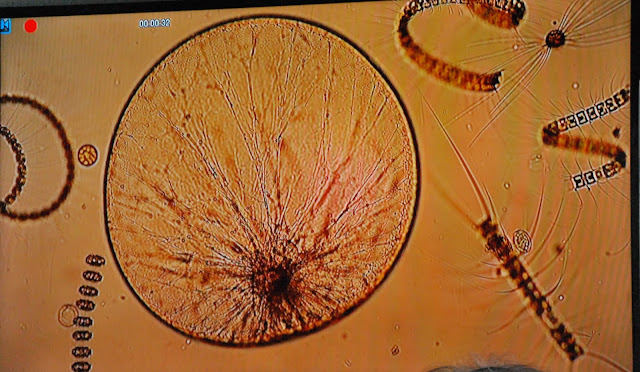Our floating classroom for the day was the Spirit of '76, a vessel that Pacific Marine Research charters for their Marine Science Afloat educational program.
The experience started off with an orientation. It included an explanation of how Puget Sound was formed, and how its present-day watershed works.
It was an educational presentation, but it was down in the belly of the boat, and seemed to take a looong time, probably because it's like, "Hey! We're on a boat on the Sound! Why are we sitting on the floor down below? I want to see the water!"
Once that was over with, things got a lot more entertaining.
CJ can give you an overview.
On May 28 of this year, I went on a (relatively) short boat trip as part of a school activity (though I am no longer a student at the school the boat ride was affiliated with, I was still able to go on the ride). The boat ride lasted 5.5 hours, and the main activities involved teaching students about the Puget Sound. Before students boarded the boat, they were separated into three categories (my sister and I were placed in the "Orcas" category).
The activities I remember from the trip are as follows (in more-or-less chronological order):
- We went over to the boat's deck, lowered a large net into the water, and caught certain types of plankton. There were two cups of water: One had a smaller variety of plankton, and another had a larger variety of plankton. Afterwards, we analyzed the plankton underneath a microscope, and attempted to match the kinds of plankton we saw in our water samples with illustrations of them on a sheet of paper (to varying degrees of success).
- We watched a "lecture" (for lack of a better word) by a teacher, providing his own analysis of a water sample provided to him. He briefly described some of the plankton he noticed.
- We briefly gazed over the Puget Sound while eating our pre-packed lunches.
- After finishing up with lunch, we watched a presentation by two SCUBA divers. The divers had a camera with them, broadcasting a video signal to TV screens on the boat. While the divers were diving, they showed up multiple different rockfish (a species of fish than can live to be octogenarians), as well as certain crabs, and even a juvenile octopus.
- Towards the end of the boat trip, we went sightseeing for two sea lions on a floating platform near our boat. The one I noticed was rather chunky.
- Lastly, the students went down in the cabin to watch a short presentation about preserving the Puget Sound from dangers such as pollution, acidification, and waste dumping.
Following are a few photos from the day's activities.
One of the first things the kids did was pull a water sample from Puget Sound to check for plankton and other life forms.
Annabelle got to help lower and raise the collection device.
The water was teeming with tiny lifeforms.
The facilitators took some of the Puget Sound soup and put it under a video microscope.
It was absolutely fascinating seeing all the different critters down below the waterline.They come in so many different shapes and sizes.
The students all had several minutes to use their own microscopes to scope out the situation.
There were also ample opportunities to check out larger Sound dwellers, like sea cucumbers, crabs and such.
At one point, I looked toward Alki Beach and saw something in the water. At first I thought it was a seal, but I quickly realized that it was a diver.
In fact, it ended up being two divers, and they were swimming toward our boat.
Turns out they did a live dive showing us what was under the waterline, near the vessel we were on. We saw everything from sea pens to rock fish to an octopus!
Between activities, we did have a chance to do a little bit of sightseeing. For instance, we spied a ferry under repair.
And we saw the Alki Point Lighthouse.I zoomed in on the Alki Beach Bathhouse, too. We went to a fun party there once ... Rick and Rachel's wedding reception.
We couldn't help but stare at T-Mobile Park (it's hard not to still call that Safeco Field, by the way).
And we even spied the diminutive Statue of Liberty replica along Alki Beach.Toward the end of our trip, I was disappointed we hadn't seen any whales or dolphins or any above-water creatures. Fortunately, these two male California seals fixed that deficit.
CLOSER TO HOME: On one of our walks last summer, we discovered an iris specimen garden just a couple of blocks from home. I made a mental note to visit it during the height of iris season this year.
Truth be told, we were more than a couple weeks past the prime time, but Leonine Iris was still an interesting sight, well worth checking out. They specialize in Pacific Coast Irises. 
FLYBY: Recently, NASA shared some footage was taken by astronaut Nick Hague, who has been onboard the International Space Station since mid-March. It's 30 minutes' worth of footage condensed into 60 seconds. (The 30 minutes of filming is about one-third of an orbit of Earth on the ISS, by the way.). This clip shows cloudy skies over the Pacific and Atlantic oceans.










































